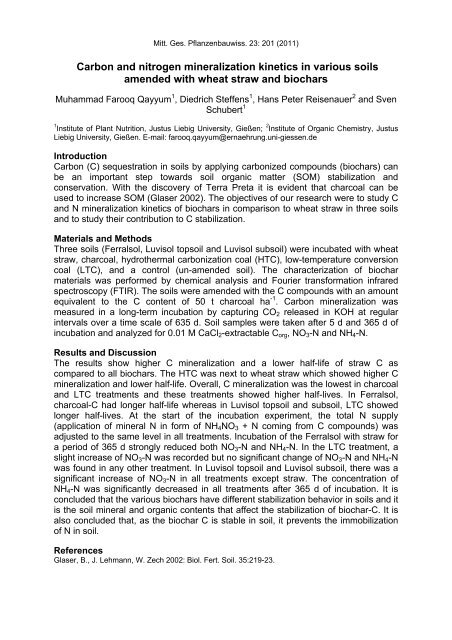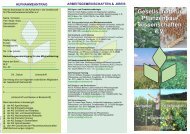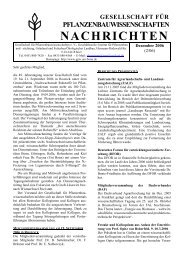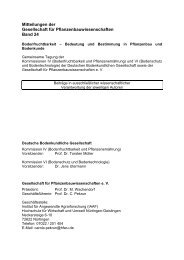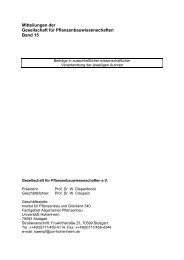Mitteilungen der Gesellschaft für Pflanzenbauwissenschaften Band 23
Mitteilungen der Gesellschaft für Pflanzenbauwissenschaften Band 23
Mitteilungen der Gesellschaft für Pflanzenbauwissenschaften Band 23
Sie wollen auch ein ePaper? Erhöhen Sie die Reichweite Ihrer Titel.
YUMPU macht aus Druck-PDFs automatisch weboptimierte ePaper, die Google liebt.
Mitt. Ges. Pflanzenbauwiss. <strong>23</strong>: 201 (2011)<br />
Carbon and nitrogen mineralization kinetics in various soils<br />
amended with wheat straw and biochars<br />
Muhammad Farooq Qayyum 1 , Diedrich Steffens 1 , Hans Peter Reisenauer 2 and Sven<br />
Schubert 1<br />
1 Institute of Plant Nutrition, Justus Liebig University, Gießen; 2 Institute of Organic Chemistry, Justus<br />
Liebig University, Gießen. E-mail: farooq.qayyum@ernaehrung.uni-giessen.de<br />
Introduction<br />
Carbon (C) sequestration in soils by applying carbonized compounds (biochars) can<br />
be an important step towards soil organic matter (SOM) stabilization and<br />
conservation. With the discovery of Terra Preta it is evident that charcoal can be<br />
used to increase SOM (Glaser 2002). The objectives of our research were to study C<br />
and N mineralization kinetics of biochars in comparison to wheat straw in three soils<br />
and to study their contribution to C stabilization.<br />
Materials and Methods<br />
Three soils (Ferralsol, Luvisol topsoil and Luvisol subsoil) were incubated with wheat<br />
straw, charcoal, hydrothermal carbonization coal (HTC), low-temperature conversion<br />
coal (LTC), and a control (un-amended soil). The characterization of biochar<br />
materials was performed by chemical analysis and Fourier transformation infrared<br />
spectroscopy (FTIR). The soils were amended with the C compounds with an amount<br />
equivalent to the C content of 50 t charcoal ha -1 . Carbon mineralization was<br />
measured in a long-term incubation by capturing CO2 released in KOH at regular<br />
intervals over a time scale of 635 d. Soil samples were taken after 5 d and 365 d of<br />
incubation and analyzed for 0.01 M CaCl2-extractable Corg, NO3-N and NH4-N.<br />
Results and Discussion<br />
The results show higher C mineralization and a lower half-life of straw C as<br />
compared to all biochars. The HTC was next to wheat straw which showed higher C<br />
mineralization and lower half-life. Overall, C mineralization was the lowest in charcoal<br />
and LTC treatments and these treatments showed higher half-lives. In Ferralsol,<br />
charcoal-C had longer half-life whereas in Luvisol topsoil and subsoil, LTC showed<br />
longer half-lives. At the start of the incubation experiment, the total N supply<br />
(application of mineral N in form of NH4NO3 + N coming from C compounds) was<br />
adjusted to the same level in all treatments. Incubation of the Ferralsol with straw for<br />
a period of 365 d strongly reduced both NO3-N and NH4-N. In the LTC treatment, a<br />
slight increase of NO3-N was recorded but no significant change of NO3-N and NH4-N<br />
was found in any other treatment. In Luvisol topsoil and Luvisol subsoil, there was a<br />
significant increase of NO3-N in all treatments except straw. The concentration of<br />
NH4-N was significantly decreased in all treatments after 365 d of incubation. It is<br />
concluded that the various biochars have different stabilization behavior in soils and it<br />
is the soil mineral and organic contents that affect the stabilization of biochar-C. It is<br />
also concluded that, as the biochar C is stable in soil, it prevents the immobilization<br />
of N in soil.<br />
References<br />
Glaser, B., J. Lehmann, W. Zech 2002: Biol. Fert. Soil. 35:219-<strong>23</strong>.


